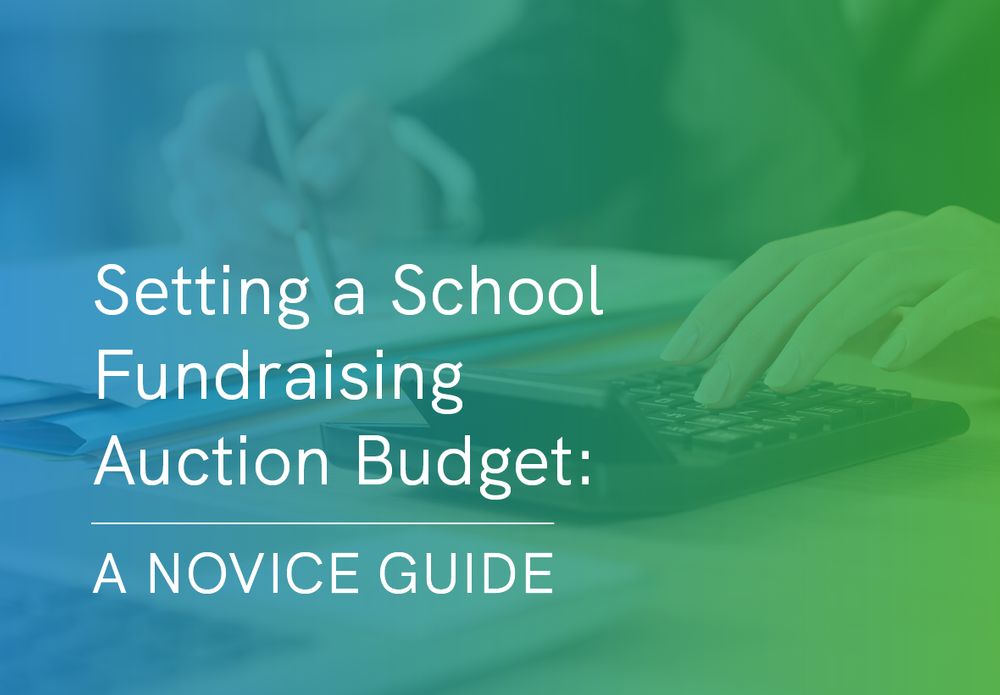As the old adage goes, schools need to spend money to raise money.
While there’s no way to completely cut costs while hosting an auction, you can plan around your expenses by using a comprehensive budget. However, if you’ve never hosted an auction for your school, creating one can be a daunting task.
Fortunately, with the right digital tools and preparation, even the most fundraising rookies can master the budget for your school’s charity auction. Let’s explore the fundamental steps of budgeting for school auctions so you can reap the biggest returns.
1. Develop comprehensive fundraising goals.
The first step of any fundraising campaign worth its salt is to establish detailed fundraising objectives so you can effectively track your progress. Besides the typical S.M.A.R.T framework (Specific, Measurable, Achievable, Relevant, Time-Bound) for goal setting, be sure your goals answer these questions:
- How can we improve this fundraiser compared to previous campaigns?
- What will happen if we don’t achieve our goal?
- How will we source our items and how does this vary from previous campaigns?
- What additional revenue-building activities can we include in the auction?
While it’s never fun to think about the worst-case scenario, it’s important to understand its impacts to make your auction as profitable as possible.
When deciding your goals, plan for multiple feasible outcomes. For example, you should determine what you’ll do if you reach 75%, 100%, and 125% of your fundraising goal so you can structure your activities in the most optimal way. Plus, it can help you add nuance to your budget depending on what threshold you want or expect to hit.
2. Map out the fundamental costs of your event.
While every auction is different, there are some costs that almost always occur, no matter what kind of auction you’re hosting. For instance, they might include:
- Cost of renting the auction venue
- Cost of auctioneer for live auctions
- Cost of custom merchandise made for the auction
- Cost of tech equipment, like screens, microphones, and auction software
- Additional operating costs, such as catering and entertainment
- An emergency fund for any contingencies
- Cost of promotion and marketing materials
- Cost of small thank-you gifts for contributors
- Cost of item displays
- For virtual auctions, the cost of delivering auction items
Ideally, you wouldn’t be buying items to auction off. Instead, your item donors will contribute in-kind donations so you can keep the money raised from their sale. Thus, you likely won’t need to put that expense on your list, unless you plan on contributing any items to the event.
To establish these costs, start with what you know. For instance, if you use the same venue each year and it’s always the same price or you run on volunteers that don’t take pay, you can pencil that in immediately. For new expenses, request quotes from rental companies as soon as possible so you can compare options and lock in a price. Don’t forget to research discounts for educational institutions to save more!
3. Explore different budget allocation options.
Once you have a good idea of your expenses, you can start building out your budget. Use the following tactics to efficiently and accurately structure your budget:
- Include itemized revenue streams. There are many ways your school can make money besides auction revenue. Some lucrative ideas to boost revenue include sponsorships from corporations or local businesses or food and drink sales at the event. Include the goal revenue from each source in your budget so you know how much effort to devote to each idea.
- Learn how to price auction items. Once you start acquiring items, you can incorporate them into their budget. First, calculate their fair market value. Then, assign them a starting price, which you can add to your budget as revenue.
- Delineate fixed versus variable costs. Noting which costs are set in stone and which aren’t gives you increased insight into your financial standing.
- Take stakeholder input into account. Your school is likely working with many stakeholders to get your fundraiser off the ground, such as the Board of Education and the PTA. Remember to take any important decision-makers’ input into account and get your budget approved so your auction follows all relevant regulations.
- Keep investment opportunities in mind. For example, if one of your costs is paying a videographer, note that the footage can be repurposed into marketing collateral that lowers the cost of future campaigns. This provides context to your budgetary choices so you can accurately reflect on them and gauge their success.
Allocating prices to your budget categories can feel like a high-stakes task. The key to staying on track while budgeting is to treat your budget like a living document. Taking a flexible approach to budgeting allows you to pivot easily when unforeseen circumstances occur.
4. Invest in the right technology.
Perhaps the most important investments you should make are in software solutions that streamline the planning, budgeting, execution, and follow-up stages of your auction. Consider investing in the following types of digital solutions:
- Budgeting software
- Auction management software
- Sponsorship management software
- Donor management software, or CRM
- Video conferencing software for auctions with a virtual component
Having robust solutions on your side empowers you to store complex data, set up workflows for your team, and contextualize your progress every step of the way. Once you’ve determined which types of technology you want to have, book demos and free trials so you can gauge which solutions best suit your needs. Then, onboard all relevant team members so that everyone can make use of it.
Wrapping Up + Next Steps
When your auction ends, your work isn’t finished yet! Now’s the time to report on your data so you know what to expand and change for your next auction. Don’t just report on if you hit your fundraising goal or not—focus on the why as well.
Use quantitative and qualitative data collected from participants to determine what was profitable and how you can play to your strengths in your next campaign. These steps can help you empower your team’s growth as a fundraising unit so you surpass your goals and provide your donors with unforgettable items in the process!




